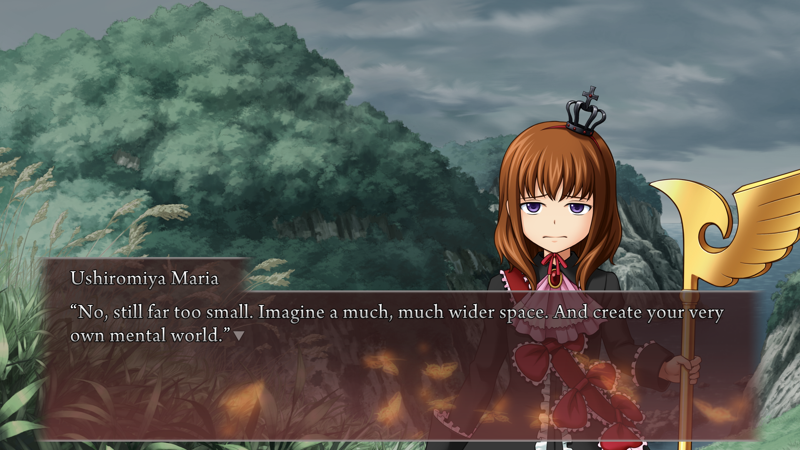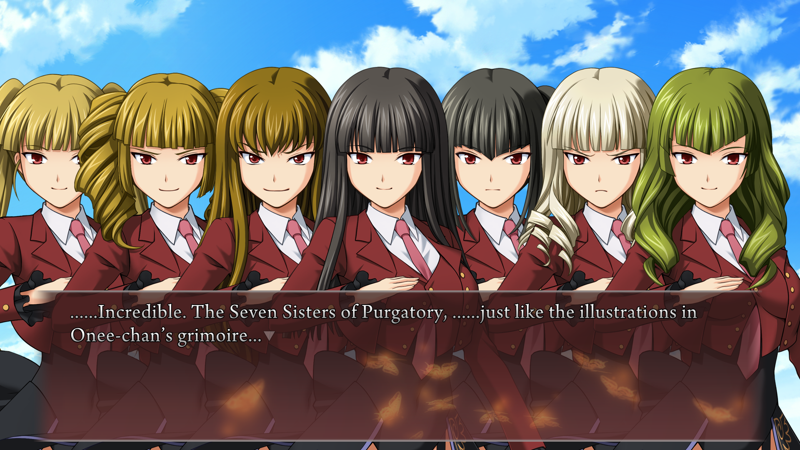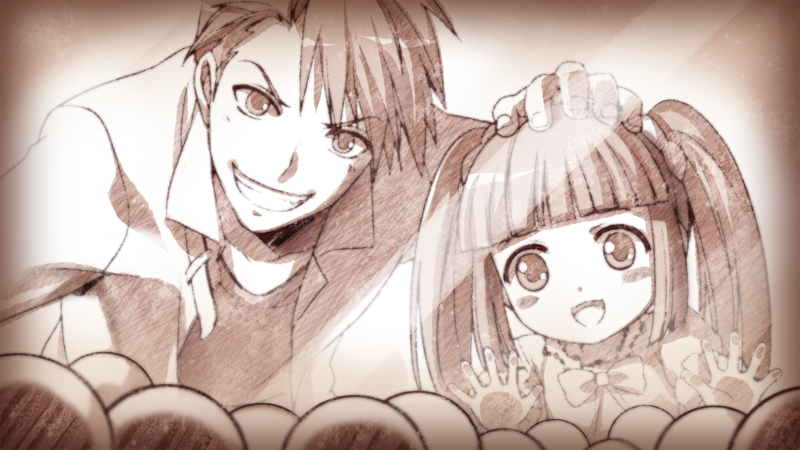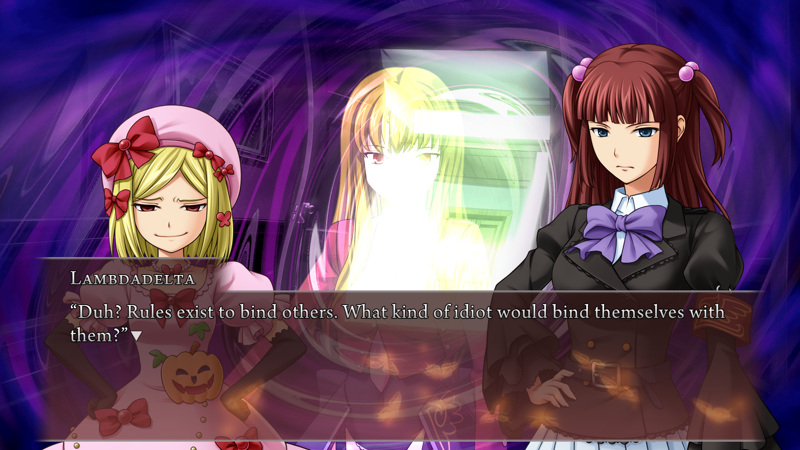みんなさん、明けましておめでとうございます!
I missed a month of this and absorbed another very long work of metafiction. I’m sorry Umineko. I’m back now. New year, more liveblog.
Thank you to everyone who wrote to me about the Witch Hunt translation group! Gabriulio wrote a wonderful comment which I’m going to quote in full…
One interesting tidbit is that The Witch Hunt translation team is not named after the in-universe group, it’s the other way around.
While the visual novel market has grown by leaps and bounds as years passed, it is still very niche nowadays, let alone back when Umineko first released. The few visual novels that had translations were, 99% of the time, those that had anime adaptations.
The cycle went: visual novel gets released in Japan, but virtually no one in the English-speaking world hears or cares about it -> it becomes popular enough to gain an anime adaptation -> people in the English-speaking world watch the anime and think it’s neat -> there’s a very small but non-zero chance of a group of fans banding together to translate the source material -> there’s an even smaller chance of the translation actually getting finished.
Higurashi, Ryuukishi’s previous work, fit all aspects of the cycle… but Umineko was different. Umineko wasn’t unknown. Higurashi had an established fanbase thanks to its anime adaptation, so Umineko wasn’t just “one of the thousand new visual novel released every year,” it was “the next work of the Higurashi creator!”. As such, there was interest in translating it even before EP1 first released, and a team of fans did just that.
That translation team called themselves The Witch Hunt.
The in-universe Witch Hunt organization isn’t named like that due to coincidence, it was a deliberate homage to the translation team. Ryuukishi was well aware of the team’s existence, and he was in fact honored that people were so interested in his work that they were translating it into an entirely different language. He even sent a letter to The Witch Hunt thanking them for their efforts, which can be found on their website.
And renasimp provided the letter in question. Ryuukishi07 is clearly kind of amazed and overjoyed at this turn of events, but I’ll quote the last para because it’s cute…
Eastern and Western world-views mix together, a world-view where reality and illusions are mixed together.
“Umineko no Naku Koro ni”
I don’t have much to say about that except it’s great and makes me happy. Shout out to the Witch Hunt, if any of them happen to read this (seems unlikely, but you never know!). Their translation is the basis for the ‘Umineko Project’ translation that I’m reading, and they have done a really killer job—idiomatic and fun to read, without erasing the character of being a Japanese work. I struggle to imagine the amount of work that went into translating a visual novel of this length.
So, new chapter. This one’s called Invitation to Fantasy. Where we left off, Ange had used the magic of Maria’s diary to summon the Seven Stakes of Purgatory, an effort that had caused her to pass out. I ventured a dubious theory that Battler Ushiromiya is like… extra fictional, like diegetically fictional.
Ange recalls the training she received from Maria a couple of chapters ago. Of course, that’s from our perspective: to her, it was years. She imagines her way to the top of a mountain, which is introduced with a cool swirly shader that I don’t believe we’ve seen before.

Maria says there’s not enough realism in this one, she’s neglecting sensory details and also it should be bigger. This, she explains to Sakutarō (Sakutarō is here), helps display the ‘toxin’ that prevents the use of magic. Most of all it has to be lonely: Ange shouldn’t lean on Maria’s mental magic world. The word used for ‘mental world’ is repeated a few times, 心象世界.
Ange succeeds in imagining her way high into the sky. Maria gives us a(nother? I forget) mention of the ‘Sea of Zero’ (zero no umi) as the source of summoned entities (furniture) like Sakutarō. Ange isn’t yet up to original summonings, but the good old Mariage gives her the right to Sakutarō. Or… any of Beatrice’s furniture. To demonstrate, Maria calls up all seven Sisters.

Viewing them all together like this, we can observe the specific variations more clearly. All Seven Sisters have the same body and face shape, and broadly similar noses and mouths. The bit that swaps is the eyes—some sisters have more rounded eyes, others more angular. All have the same iris shape and colours, but different highlights and sizes and positions. It’s interesting to see the design space hehe.
We get some playful interaction scenes. Mimetic words like ぷにぷに and ふわふわ fly. We are assured that the nonagression pact means Sakutarō is at no risk. Maria transfers the summoning over to Ange, as a training exercise: she must try to maintain all seven at once. It turns out to be too much. We learn that when the Sisters fight and argue, the magical strain is increased. In the end she can only sustain one sister, which ends up being Mammon.
One thing I’m wondering at this point is whether we’re steadily getting one solid magic system explicated in pieces, or if it varies between episodes—iterations on a theme. Enough is vague that it’s hard to tell.
Ange runs out of time, and we get a slight twist: this dream took place not during Ange’s dream at the hotel, but back in her days at Saint Lucia. So that’s why she found Mammon the easiest to summon. That means there are now three points in her life when Ange practiced magic. She’s hiding in a bathroom to read because it’s one of the only places she has the slightest bit of privacy.
Mammon is quick to recognise the prison-like vibe of the ‘school’ Ange is attending, with its uniform pyjamas and collective punishment for missing roll call. As we might reasonably expect, Mammon is invisible to anyone but Ange. No hopes and dreams means no access to magic.
And then things take a turn for the tremendously sad, because what Ange really wants to summon is her family. Despite being way above her level, or even Maria’s, this is the goal. She has a hair accessory associated with a memory of Battler, which has the potential to act as a vessel to bring him back.
Naturally a flashback ensues. Umineko will never tell when it can show, show again, and go over it once again for a reminder. Battler playing the gachapon game on Ange’s behalf merits a CG.

Battler gets the gacha, “reaching out to get [Ange’s] happiness with his long arms”. This is a repeat of the motif from episode 1 then, of a cheap plastic charm being imbued with power due to the emotional significance attached to it.
Mammon gets excited at the prospect of belonging to a Witch of Resurrection. She says the ‘worth’ of furniture is proportional to the rank of its master. Recalling that the Sisters were completely outclassed by the Chiester bunnies, I wonder if perhaps this is an indication that the Dragon King—should we ever meet him—is stupidly high up in the ranking. It’s not exactly clear where Beatrice (OG variety) stands—the right to be Endless Witch seems like a big deal, but there also seems to be wild bunnygirl space battles happening offscreen somewhere, while Beatrice is still stuck trying to get off Rokkenjima.
But then, the idea is that she’s a bigshot who’s been brought low by an unworthy sorcerer, I guess. Similar plot point in Sandman. And perhaps Earth is uniquely blanketed in an antimagic field.
The flashback ends with Ange resolving to one day summon all seven sisters, and we return to the ‘present’.
Anyway, one thing I’m thinking about a lot now that we’ve seen the reveal of the mysterious diegetic author who wrote Maria’s supposed diaries is, and the thrust of these chapters seeming to be the importance of constructing an elaborate fantasy world to cope with loneliness and trauma… if someone is concocting all of the Rokkenjima-side events as fiction, why would they do it?
The role of furniture seems to be a huge factor in the affairs of witches. A proper witch’s furniture is happy to serve, indeed living for nothing else, in a beautiful symbiotic relationship with their master, who values them and has their life significantly improved by the presence of furniture. So it seems.
Now, suppose one of the ‘-on’ servants at Rokkenjima were the author of the diaries, from Kinzo’s orphanage, it would be easy to imagine that they’re working through some shit. If you’ve spent your entire fucking life being told you are an object, existing for the pleasure of a bunch of rich bastards, and you ought to be happy about it, it would be easy to imagine that you’d invent a fantasy world where you try and imagine characters who do live up to that ideal.
So, suppose the author is Sayo. We could apply a similar analysis to, say, Ushiromiya George, who in this fantasy plays the role of love interest—the classic ‘generically sweet rich guy plucks you out of your miserable life, falls in love with you, and gives you a life of comfort and acceptance’ fantasy. George as we’ve known him in the story so far is kind of a huge cunt, but if you only ever encounter him as a visitor from afar at the family conference, it would be very easy to imagine a scenario where he’s got a heart of gold and is just dying to ask for your hand in marriage.
What about the other Ushiromiya siblings, Maria and Jessica, who come off decently well in the narrative? Once we start declaring that characters aren’t real, left right and centre, we might end up denying the whole cast, so let’s assume that these people exist, but we haven’t necessarily been told the truth about them. Maria is the one who the mysterious author chose to ventriloquise in releasing this story, and if her fascination with the occult is real, that might have something to do with the theme? And if we’re assuming the author is someone who lives on Rokkenjima, they’d have a lot more familiarity with Jessica since she’s always present, so it makes sense that her characterisation is a little more grounded.
That someone is the author of the diaries does not necessarily mean that they’re responsible for the murders on Rokkenjima of course. It doesn’t even mean that they survived. All we know is that the police didn’t find them alive, but given the evidence seems to be that most of the bodies weren’t recovered…
We cut to Ange… not the Ange who’s sleeping over in a hotel while searching for evidence on the ‘Ange side’, but the Ange who ducked out of Rokkenjima. Mammon at this point in the timeline has no reason to recognise her. But Mammon seems to be aware that this ‘Gretel’ is Battler’s brother…
Mammon: 戦人お兄ちゃんに、出会えて
Mammon: You being able to meet Battler onii-chan.
I found it in the process of transcribing this that I can just… read the Japanese script. Which is great because that’s not 出会って but 出会えて which is a potential te-form there—a surprise combo of the potential form and the te-form—and there’s no way I’d have figured that one out. In fact I can find very few articles in English on it, but it seems one of the rare times it’s used is when you particularly miss someone, with 会う (to meet).
The more important point is that she said onii-chan, the honorific used for an older brother. She Knows. And as their conversation goes on, she knows more than that:
Mammon: …………….Please do the best you can. Although I can’t support you, seeing as my current master is Beatrice-sama.
Ange: I know. Until October 5th, 1986, …you are Beatrice’s furniture. And eventually, you become my friend.
Mammon: And eventually, you throw that friend away. After all, ……ng, ………ghkh…
Some kind of ‘rule’ inflicts a severe pain on her. I guess she’s not allowed to spoil us. She nevertheless has future knowledge. But just as Ange’s about to get back to the game, who should appear but…

Lambdadelta.
Much like Bernkastel, Lambadelta’s appearance stops time. Would this affect Beatrice? I wonder… In any case, it seems Ange recognises her, seeing both those witches as ‘like beings from a higher dimension’. Beyond that, all she really knows is Bernkastel friend, Lambdadelta enemy.
Ange tries to stonewall her, dropping the old <see you next time>. I don’t think it will be that easy. And indeed, Ange concludes that Lambdadelta can stop time indefinitely, so she’s forced to hear the witch out. What’s the ΛΔ move then?
“Bernkastel has lied to you”, basically. Specifically, about the possibility of reuniting with Battler if Ange wins. The dance music kicks in as she drops this line:
Lambdadelta: WELLLL? ON YOUR OCTOBER 6TH, 1986, DID BATTLER ONII-CHAN COME HOOOME?
OK, quickly derive implications of this: the timeline must remain consistent outside of the unsettled bubble on Rokkenjima. If Battler et al. survived the ‘massacre’, then for reasons unknown, they appeared dead to the outside world, and Ange’s life would be no different.
This doesn’t really go too far, though, because Ange has already lived through that traumatic period—she wasn’t promised a do-over. The real question is whether, in the ‘Ange side’, she might stumble on a survivor besides Eva.
This does have one other surprising implication though: the Ange side is basically set in stone. It’s not going to be rewritten in future episodes. So Eva definitely came out as the ostensible sole survivor of Rokkenjimagate. That’s going to constrain our hypotheses a lot I think. It doesn’t prove Eva dunnit, but it’s hella incriminating. But also that’s pretty much what I was assuming anyway?
…except that’s not what Lambda is saying, I jumped to conclusions. Actually what it means is, the timeline in which Battler et al. survive will contain a different Ange, separate from the one in this timeline. Ange comes, in Homestuck terms, from a ‘doomed timeline’.
Lambdadelta explains that this ‘Ange’ is a witch’s game piece. Whatever victory Ange achieves, she will never subjectively experience a ‘real’ reunion with Battler…
Lambda further suggests that Bernkastel has gone through the same thing: winning a game and realising she’d only saved an alternate timeline self. I assume that happens in Higurashi.
Helpfully, Ange displays a rather impressive memory of Bernie’s exact wording. She was pretty careful not to overpromise, honestly—just that she’d find this Ange a home in one of the billions of fragment, which Lambda confirms. Lambda blusters a bit about Beato’s perfect game board, but really the point of this whole exercise seems like a fairly weak attempt at psychological warfare and casting doubt on Bernie.
Lambda has buried the lede, though: as a piece on the board, if Ange wins and wipes away the game, she’ll go with it. With (Witch guaranteed) certainty.
See, Lambda, you might have had buildings dedicated to you by ancient kings[dubious - discuss], but I know one thing with certainty too: people don’t talk about Umineko in the tone they use for End of Evangelion, so I think we might have slightly better odds than all that.
However, Lambda is coming here with a proposal: if Ange should deliberately throw the game, she could stay in the bubble with Battler indefinitely. An overture to defect, in short, though it’s Lambdadelta so she’s kind of an ass about it. It’s not enough to throw the game though—she needs to also prevent Battler from losing completely. (None of his losses so far have ‘counted’, I guess. He pretty much surrendered outright in game 2, but then he got back up again, and game 3 was… weird.)
Lambdadelta: What is the happiness of a game piece? ……Nothing more than being played with in the game. It doesn’t come when the game’s shut in the closet, gathering dust, right?
Compare the happiness of a game piece and the happiness of furniture, huh. …and Ange draws that comparison herself in the very next line. Damnit. First you push Battler to up his game, now you’re demanding I up mine.
Lambdadelta goes over her desired outcome again. For her, the game is against Bernkastel, and the win condition is to keep Bernkastel trapped in an endless game until she gives in. For Beatrice, the game is against Battler, and the win condition is for Battler to give up and accept magic.
For us the players? Our win condition is to have a good time, but it’s also to find a satisfying frame to interpret all these parallel stories.
Ange does not take all this well. But I think, in making this overture, Lambdadelta has given us something important. If she truly thought, with certainty, that Ange could not tip the balance and win the game, she wouldn’t bother. A win is possible. (We were assuming that anyway, but it’s good to see the fire under the opponent’s feet.)
Lambda further promises that if Ange swears to become her piece, she’ll relax the ‘rule’. I went over my notes on previous chapters and I’m not exactly sure what rule it is, if it’s the same one that silenced Mammon. Maybe the rule that she can’t be physically present?
Anyway, evil laugh from Lambda and that closes out the chapter.
Not much more to add on this one. Doomed timeline/infinite repeat stuff is a classic.
Comments
Branwen
I honestly think its more likely than you might think that one of the witch-hunt folks might read this at some point! A lot of Umineko fans derive great joy from seeing other people’s theories and reactions, and they’re no normal fans!
Minia
Maybe its the phrasing and you weren’t actually confused and it’s me reading your post wrong, but a slight potential misreading-Marias diary was written by Maria, but there was a single letter to Maria written by “Beatrice” in it, who is also the person who wrote the message bottles for what seems to be episode 1 and 2. The rest of her diary was written by her.